
Many people struggle with a dog that has an emotional issue such as being timid, fearful, shy or insecure. The dog sometimes becomes a biter because it does not know how to deal with everyday life and stressful situations. The conflict in the owner’s head is they know their dog reacts badly, but they also know their dog has an emotional problem. The owner tends to give the dog a pass on its reactions and begins to avoid all situations that might set the dog off. A lot of owners unknowingly escalate the problem as they try and fix it, while others escalate it simply by accepting the poor behavior.
Let's say you have a dog that is afraid of strangers and you are walking down the street with your dog. A stranger quickly approaches and you freak out, telling the stranger to “stay back, stay back, my dog bites!” By the time you get your dog safely back to your car, you are an emotional wreck because you know what could have happened had the stranger actually run up and touched your dog. Yes, you saved a bite from happening and that was a good thing, but let's look at the effect you just had on your dog.
The dog is walking down the street and a stranger is coming at it quickly. Unlike most humans, a dog can feel the emotions coming from the humans around it. It's the same ability that allows some dogs to sense when a human is going to have a seizure. It's an ability that most humans do not have and if they do it's nowhere near as strong as a dog's. It is possible that the dog is simply smelling pheromones radiating from the body, but in any case, a dog knows how you feel and you cannot hide it. When there is a situation that makes the dog's handler upset, the dog knows it and reacts accordingly. This owner just reinforced to their dog that there was something to be very, very afraid of about that stranger approaching.
When a human knows their dog has a problem they anticipate the dog's reaction. The human reacts to what they think will happen and the dog reacts to the handler's emotions, and so the cycle continues.
Often the owner tries to fix the problem with treats and avoidance, at the same time feeling very sorry for the dog. Feeling sorry is perceived by dogs as a weakness. The missing link to the whole solution is how the dog is picking up on its handler’s own feelings.
This is often very difficult for some owners to fix because it is hard for a human to change how they feel, especially when they have seen firsthand how their dog can react to situations.
Quietly and calmly, with an air of authority that the dog can trust, you need to tell the dog you do not like its reaction and you also need to set an example of how there is nothing to be afraid of. If you are a mentally weak person, you are not going to be able to pull your dog out of a fear state into a balanced state. This is the hard part, realizing and accepting your own feelings. If your dog gets into a fight with another dog, from that point forward when you see a dog approaching, you as the human are naturally going to have certain uneasy feelings, be they fear, anxiety, worry or stress. When the dog picks up on this, it will react.
A lot of people claim this approach does not work and for many it does not because they themselves are not balanced. If a human is anxious, unsure, nervous or afraid, the dog will pick up on it and not listen. In order for you to truly balance your dog you first must balance yourself.
Your dog does not need coddling and treats when it is afraid, it needs a strong leader. Someone who can be a strong rock to feed from. When something scares the dog, it needs to see there was nothing to be afraid of. It needs to see the human not react and it may need to see what made it afraid again. If I drop something loud onto the floor and my dog jumps and runs away, I will pick up the object that fell and gently drop it again so the sound is the same but softer. I calmly and quietly show the dog what the sound was and how it will not hurt him. My dogs have always reacted by walking slowly over to smell the object. I am careful to make the follow-up drops less intense. When the dog approaches, I set the object down and let him smell it. Quietly and calmly, without words, showing them I am not afraid and there is nothing for him to fear either. If I were to overreact to the noise, I just might create a situation where my dog will be fearful from that point on of that type of noise.
Once a dog does develop a fear it takes time to rehabilitate it. Oftentimes it is the human who is unknowingly holding onto the fear by reacting and teaching the dog it has good reason to be afraid. Helping the dog get over its fear is not done with human words, sweet-talking and coddling. It does not have to be done with food. Food is a good tool, but it should not be your main focus. The key to pulling a dog out of a fearful state is to dig deep within you. Be honest with your own human feelings. You must be strong for the dog. Strong, calm, confident with an air of gentle but firm authority in order to give the dog something to feed from.
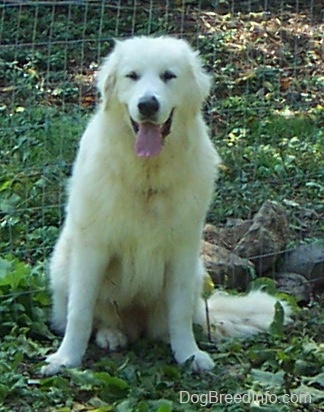
When I first adopted Tundra, my Great Pyrenees, he was a 7-month-old, 90-pound dog who was afraid of everything. He came from show lines and his nose was not black enough for the show ring. This banished him to a kennel where he was not socialized, was never given a name or taught any basic obedience. Not even sit.
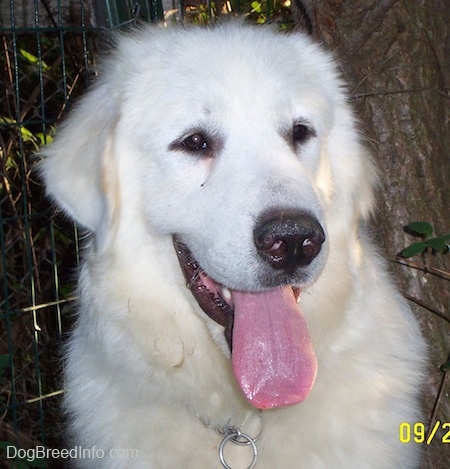
When I say afraid of everything, I mean everything: unknown noises, humans, especially children, and strange objects. He would drool, shake and try and bolt and hide. I would often find him cowering in his doghouse shaking and drooling. If I needed for him to come out I would have to get the leash slipped around his neck and coax him. Luckily, he would submit to the leash once it was around his neck and he would come out. Without the leash it was nearly impossible to move him.
Tundra had many little issues. For example, he had an outside metal water bowl. I had switched it out for a new maroon plastic bowl. After a bit, I realized he was afraid of his new bowl! He would not go near it. I decided to put his metal bowl back out, but I kept the bowl he was afraid of out in the yard, too. I didn't push the bowl on him, but I didn't hide it away, either. He eventually realized the bowl was not going to hurt him.
Unlike what most people assume about a fearful dog, I do not think he was abused as a puppy, but quite the opposite. He was obviously under-socialized but in addition, someone most likely gave him love and affection instead of leadership when he was scared which intensified his fears. Good boy for feeling this way and you have no one to look up to for guidance.
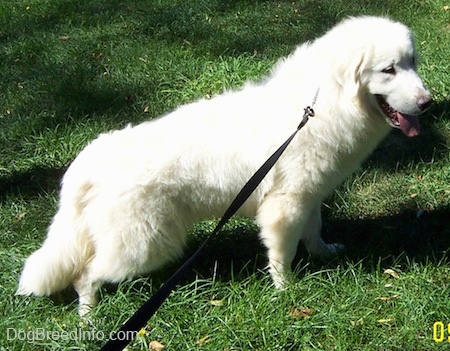
I was able to pull him out of his fear by calmly, quietly and confidently showing him things. I taught him how to walk on a leash and I became the leader he needed so he could look to me for strength. I did not use a food reward and I did not feel sorry for him. I did not use avoidance as a solution tactic and I did not work on every individual obvious issue, as that is only a Band-Aid. I looked at the big picture. He was afraid and he needed to feel confident and secure. This was not done by working on every single quirk individually, but by changing the way he lived, which in return would naturally change his overall behavior. I wanted to fix his issue, not spend the rest of his life catering to it.
I learned to read his body language and I learned to show him in dog language that there was nothing to be afraid of. I never hesitated to calmly tell him no in an authoritative tone. It helped him feel secure by knowing the rules and we both had a mutual respect. I made the calls and he had a leader to follow.

I also gave him a job to do. He began to work on our farm as a flock guard. I watched for signs of things that truly pulled him out of his shell and I worked off of those things.
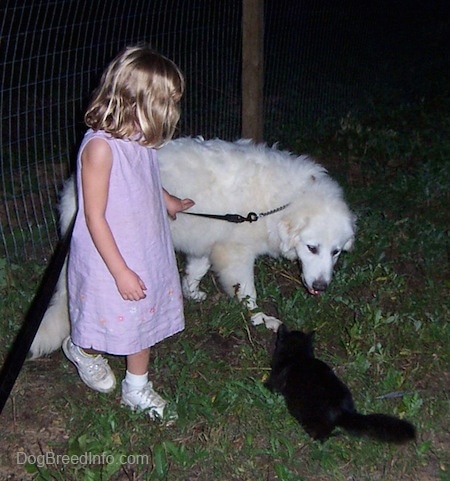
My kids had been taught to be firm, gentle pack leaders and they too showed Tundra there was nothing to fear.
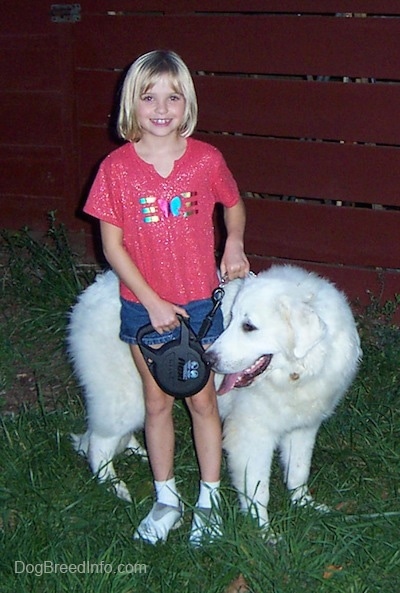
We made good noticeable immediate progress and within a few months, every single one of his issues simply disappeared because our entire family balanced his life. We didn't just pop treats to his individual quirks and he didn't get a pass on discipline just because he had a tendency to be afraid. For example, just because someone opened the gate didn't mean he was allowed to bolt through it. We didn't give him a treat for not bolting; we told him NO when he tried to bolt. This made the rule very clear. An open gate is not a pass to leave. Tundra accepted this rule and was more secure because the communication was clear. Tundra didn't have a Band-Aid for his issues, he had a lifetime transformation.

Tundra turned into and has remained a very well-mannered, respectful, submissive, confident dog that is not afraid of anything. Not even children.
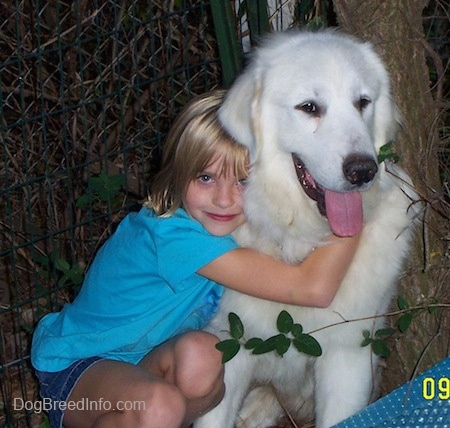
Amie giving Tundra a hug.
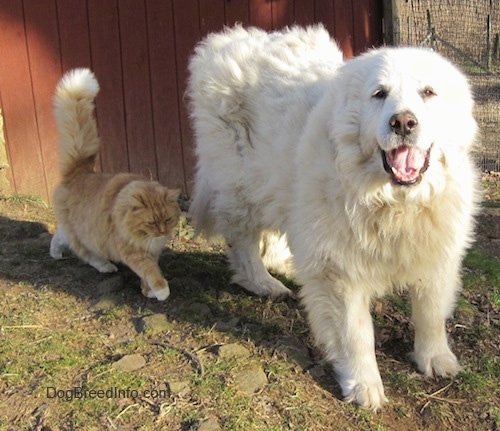
Ten years later, Tundra still remains a happy, well-behaved, trustworthy, balanced, stable-minded dog that will walk up to any child to be petted. He started out as a fearful type. With a different owner who didn't take the time to look at the big picture and work on satisfying all of his natural instincts his life story could have been much different. He may have fallen victim and become one of those misunderstood dogs that gets a hundred treats a day, but is never truly transformed into a balanced dog. Or worse, he could have turned into a fear biter with an owner who gave up and had him killed.
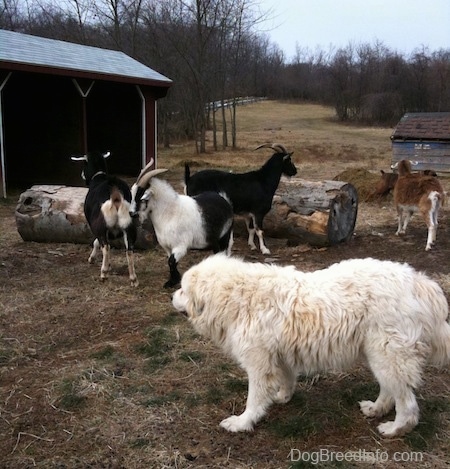
Too often I see people deal with fearful dogs by avoidance and human submission tactics. They are afraid to give their dog leadership because somehow they think it is cruel. What they don't realize is the lack of structure in the dog's life is contributing to its fear in the first place. The dog has uncertainty all around it. It does not have a balanced, stable leader to look up to and no one is satisfying its canine instincts. It can be a confusing world living with humans who want a dog to be human rather than helping the dog be a dog.
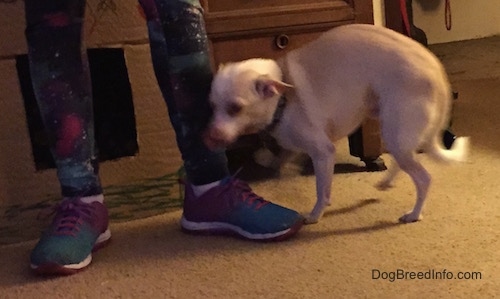
This is an example of an unsure, fearful dog. Notice how the dog is trying to slink his body up into a small ball, as if to want to disappear out of sight. After a while this dog warmed up and decided to trust the person taking the picture, but his first reaction was to fiercely bark and growl. It sounded as if he wanted to bite and attack, but the dog was actually very afraid. He had learned to respond with an act. After he was told to hush from what appeared to be attack mode, he resorted to slinking away and hiding. He needed to be told to hush, because that was the only way he was going to learn attack mode is not an acceptable reaction to fear, which was a new conscept for him. In the past the humans would pet, hold and sweet talk him, which was, in the dogs eyes, saying "Good boy for feeling like this and good boy for your reaction." Now he was told, "We do not agree with your reaction or the way you are feeling." When dogs are afraid there are three things they tend to do, fight, run away and/or avoid. This dog went from fight to flight and avoid.
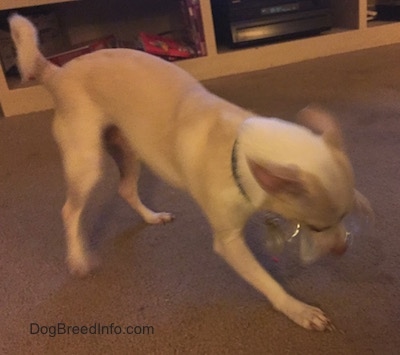
The stranger kept quiet and allowed him to approach on his own terms. Kneeling down to his level, but not making eye contact. Keeping quiet and ignoring him as he approached gave him the courage to slowly walk up and smell the person. That is when he warmed up and started to play with his toys. Even playing with the stranger.